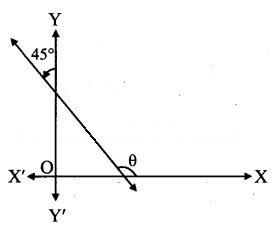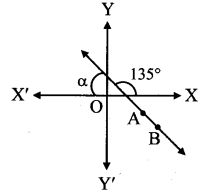Question 1.
Find the slope of each of the lines which passes through the following points:
i. A(2, -1), B(4,3)
ii. C(- 2,3), D(5, 7)
iii. E(2,3), F(2, – 1)
iv. G(7,1), H(- 3,1)
Solution:
i. Here, A = (2, -1) andB = (4, 3)![]()

Alternate Method:
Points E and F have same x co-ordinates i.e. 2.
Points E and F lie on a line parallel to Y-axis.
∴ The slope of EF is not defined.
iv. Here, G = (7, 1) and H = (-3, 1)![]()
Alternate Method:
Points G and H have same y co-ordinate i.e. 1.
∴ Points G and H lie on a line parallel to the
X-axis.
∴ The slope of GH is 0.
Question 2.
If the x and x-intercepts of line L are 2 and 3 respectively, then find the slope of line L.
Solution:
Given, x-intercept of line L is 2 and y-intercept of line L is 3
∴ The line L intersects X-axis at (2, 0) and Y-axis at (0,3).
∴ The line L passes through (2, 0) and (0, 3).![]()
Question 3.
Find the slope of the line whose inclination is 30°.
Solution:
Given, inclination (θ) = 30°
Question 6.
Without using Pythagoras theorem, show that points A (4, 4), B (3, 5) and C (- 1, – 1) are the vertices of a right-angled triangle.
Solution:
Slope of AB x slope of AC = – 1 x 1 = – 1
∴ side AB ⊥ side AC
∴ ∆ABC is a right angled triangle right angled at A.
∴ The given points are the vertices of a right angled triangle.
Question 7.
Find the slope of the line which makes angle of 45° with the positive direction of the Y-axis measured anticlockwise.
Solution:
Since the line makes an angle of 45° with positive direction of Y-axis in anticlockwise direction,
Inclination of the line (0) = (90° + 45°)
∴ Slope of the line = tan(90° + 45°)
= – cot 45°
= -1
Question 8.
Find the value of k for which the points P(k, -1), Q(2,1) and R(4,5) are collinear.
Solution:
Given, points P(k, – 1), Q (2, 1) and R(4, 5) are collinear.
∴ Slope of PQ = Slope of QR .
∴ 4 = 4 (2 – k)
∴ 1 = 2 – k
∴ k = 2 – 1 = 1
Question 9.
Find the acute angle between the X-axis and the line joining the points A(3, -1) and B(4, – 2).
Solution:
Given, A (3, – 1) and B (4, – 2)![]()
But, slope of a line = tan θ
∴ tan θ = – 1
= – tan 45°
= tan (180° -45°)
… [∵ tan (180° – θ) = -tan θ]
= tan 135°
∴ θ = 135°
Let α be the acute angle that line AB makes with X-axis.
Then, α + 0 = 180°
α = 180°- 135° = 45°
∴ The acute angle between the X-axis and the line joining the points A and B is 45°.
Question 10.
A line passes through points A(xi, y0 and B(h, k). If the slope of the line is m, then show

Question 11.
Solution:
Given, A(h, 0), B(0, k) and C(a, b)
Since the points A, B and C lie on a line, they are collinear.
∴ Slope of AB = slope of BC
